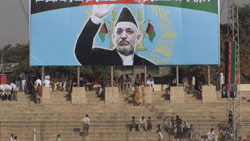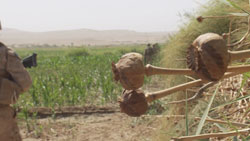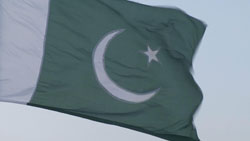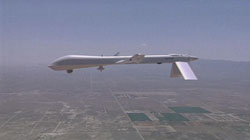The CIA and U.S. military draw up plans for an "unconventional war" in which CIA officers would link up with anti-Taliban guerrillas inside Afghanistan. They would later be joined by small U.S. Special Operations units who would call in precision airstrikes on the Taliban and Al Qaeda. It was to be a war of many bombs, a handful of U.S. troops on the ground, and America's Afghan allies taking on the bulk of the fighting. The airstrikes begin on Oct. 7, and the ground war starts on Oct. 19, when Army Rangers and Delta Force operatives strike a Taliban compound in Kandahar.

On Dec. 5, Pashtun leader Hamid Karzai receives a phone call that he has been elected to lead Afghanistan's new interim administration at the U.N.-convened Bonn Conference. Two days later, Karzai and a team of U.S. Special Forces enter Kandahar, the last remaining Taliban stronghold. The same month, Osama bin Laden is believed to have escaped to Pakistan via the Tora Bora mountains, the site of two weeks of heavy bombing and ground fighting.
Expected to be a 72-hour battle, Operation Anaconda -- an attempt by more than 2,000 U.S. and coalition forces to push Al Qaeda and Taliban operatives out of the Shah-e-Kot Valley in eastern Afghanistan -- lasts for more than two weeks. Coalition commanders had been expecting to find between 150 and 200 enemy fighters in the valley; after their arrival, they find an estimated 500 to 1,000.
The heaviest U.S. casualties occur on March 4, the third day of the fighting, when Navy SEAL Neil Roberts falls out the back of a Chinook helicopter that had been damaged by heavy Taliban fire. Two more helicopters fly back to rescue Roberts, who had been captured and killed. An 18-hour battle ensues in which six more Americans die. U.S. forces had not suffered such a high number of casualties in one single day since the 1993 battle in Mogadishu, Somalia, where 18 Rangers and Special Operations soldiers were killed.
As a result of Operation Anaconda, several hundred foreign fighters flee into South Waziristan, in Pakistan's tribal areas, and settle in the Shakai Valley.
Also in March, the CIA and the military begin to scale back operations in Afghanistan and move military and intelligence assets to Iraq.
After a week-long loya jirga, a traditional Afghan grand council, Hamid Karzai is elected president with more than 80 percent of the vote. Attending the loya jirga are approximately 1,500 delegates -- including 160 women -- who are chosen from districts throughout the country. For more than a week they passionately debate the overwhelming issues facing Afghanistan, from security to hunger to illiteracy.
On the day President Bush speaks aboard the USS Lincoln under a banner declaring "mission accomplished" in Iraq, Secretary of Defense Donald Rumsfeld tells reporters at a press conference with President Karzai in Afghanistan, "We clearly have moved from major combat activity to a period of stability and stabilization and reconstruction and activities." At the time, about 8,000 American soldiers are stationed in Afghanistan, with an additional 5,500 peacekeepers stationed in Kabul.
The December 2001 Bonn Conference had established an International Security Assistance Force (ISAF); various countries head the force for six-month rotations until August 2003, when NATO assumes control. The ISAF's initial mandate is to provide security in and around Kabul; its area of operations gradually expands until Oct. 5, 2006, when it takes responsibility for the entire country.
After being forced from Afghanistan, Al Qaeda's global operations move to South Waziristan, in Pakistan's tribal areas. The head of the local Taliban is Nek Mohammed, a young, charismatic Pashtun tribesman, who previously headed an Al Qaeda training camp near Kabul.
The United States presses Pakistan to do something about Mohammed, but it isn't until two assassination attempts against President Pervez Musharraf -- one linked to South Waziristan -- that the government sends gunships and 5,000 troops into the area in March 2004, targeting Al Qaeda camps and Mohammed's home in the Shakai Valley. The fighting is fierce and the government suffers heavy casualties. President Musharraf orders the army to begin negotiating with the militants.
A month later, South Waziristan tribesmen gathers at the main madrassa in Shakai to witness an agreement between the government and militants. According to the government, Mohammed agrees to lay down arms and "register" foreign militants living in the area. Gen. Safdar Hussein, a top army commander, is sent to bless the deal. Government officials also agree to give money to the militants so they could pay their debt to Al Qaeda.
The deal breaks down almost immediately; Mohammed claims he never agreed to identify or hand over any Al Qaeda militants and the Taliban begin killing tribal elders who helped broker the agreement.
After the breakdown of the peace deal and under pressure from the U.S. to do something about the increasing number of attacks on U.S. forces in Afghanistan, Pakistani troops launch a summer offensive in Waziristan. They are surprised by the intensity of the fighting, which they interpret as reflecting the presence of senior Al Qaeda leaders in the area.
In June 2004, Mohammed is killed by a Hellfire missile fired from an unmanned U.S. Predator airplane. He is hailed as a martyr and his grave has become a shrine. A young Pashtun tribesman named Baitullah Mehsud takes his place as head of the South Waziristan Taliban.
After investigating allegations of voting irregularities, a U.N.-appointed panel declares Hamid Karzai Afghanistan's first directly elected president. Despite threats of violence from the Taliban and Al Qaeda, Afghanis turn out in high numbers to vote in the Oct. 7 election, and Karzai receives 55 percent of the vote.
The U.S. launches a missile strike targeting Al Qaeda number two, Ayman al-Zawahiri, in Damadola village in the Bajaur Agency. Zawahiri escapes, but 18 people are killed, including four Al Qaeda operatives and several woman and children. Outraged Pakistani religious parties hold demonstrations across the country; the Pakistani government distances itself from the operation.
Spontaneous rioting breaks out in Kabul after an incident in which a U.S. military truck loses control and crashes into 12 cars. An estimated 20 are killed and 160 wounded in the rioting. The incident exposes tensions stemming from the public's frustration with the slow pace of reconstruction and what's seen as arrogant behavior by the U.S. military.
In the spring of 2006, the Taliban launch an offensive in southern Afghanistan resulting in a reported six-fold increase in suicide bombings and a 45 percent increase in NATO casualties. The Pakistani Taliban also launches an assassination campaign against pro-government tribal elders.
The Pakistani army launches an operation in North Waziristan but suffers hundreds of casualties. On Sept. 5, the government and the Taliban sign a peace deal in which the militants pledge to stop cross-border attacks into Afghanistan and to stop attacking Pakistani forces. The Taliban also promises to expel foreign militants who don't abide by the previous two terms. In return, Pakistan recalls its forces and releases 132 detained insurgents.
In December, The New York Times reports that the Taliban and foreign militants have taken advantage of the peace deal to create "a Taliban mini-state." And the top American commander in Afghanistan, Lt. Gen. Karl Eikenberry, notes that in December, Taliban attacks in Afghanistan rose 200 percent compared to December 2005.
Operation Achilles, which involves 4,500 NATO troops and 1,000 Afghan soldiers, is intended to pre-empt an anticipated Taliban spring offensive and clear and improve security in Helmand province.
Mullah Dadullah, one of the most wanted Afghan Taliban commanders, who had recently told the BBC that he had "hundreds of suicide bombers awaiting his orders to launch an offensive against foreign troops, " is killed in Helmand province.
An unclassified summary (PDF) of a new National Intelligence Estimate warns of a resurging Al Qaeda: "We assess the group has protected or regenerated key elements of its Homeland attack capability, including: a safe haven in the Pakistan Federally Administered Tribal Areas (FATA), operational lieutenants, and its top leadership."

Poppies in Helmand province
An annual U.N. survey (PDF) of opium production in Afghanistan declares that it has "reached a frighteningly new level, twice the amount produced two years ago," largely driven by an explosion in production in southwest Afghanistan. According to the report, 50 percent of the Afghan opium crop is grown in Taliban-controlled Helmand province.
In January, a Pakistani airstrike kills several dozen militants in South Waziristan. Taliban leader Baitullah Mehsud vows to avenge the attack using suicide bombers; in February, The New York Times reports a spate of six suicide bombings in the month after the attack.
In early 2007, radical students studying at seminaries attached to Islamabad's Red Mosque begin a violent campaign to impose sharia law in Pakistan's relatively secular capital, kidnapping policemen and harassing citizens. In July, after attempts to negotiate with the mosque leader Abdul Rashid Ghazi fail, the army storms the mosque; more than 100 people, including Ghazi, are killed. Ghazi's older brother, Maulana Abdul Aziz, is captured, dressed in a burka, while trying to escape. Two years later he is released after the Supreme Court rules there is insufficient evidence to hold him.
The siege on the Red Mosque marks a turning point; violence inside Pakistan surges as Baitullah Mehsud and other militants essentially declare war on the government.
Led by Maulana Fazlullah, a radical cleric known as "the radio mullah" for his sermons and tirades broadcast on his pirate radio station, the local Taliban takes over 60 towns in a matter of months in Pakistan's Swat Valley, an idyllic vacation destination 100 miles from Islamabad.
When Fazlullah's men start capturing local police stations and seizing weapon arsenals, the people of Swat plead with the government to take action. But Musharraf's regime responds slowly and half-heartedly, sending in the Pakistani Frontier Corps, a poorly trained civilian militia, low-paid and outnumbered. The Taliban decimates the fighters, leaving their bodies to rot in fields. The Taliban also murder a policeman and behead others who stand in their way, leaving notes that read, "Those people who serve America, the same thing will happen to them."
On Nov. 3, Musharraf, who had tried to strike a deal with Fazlullah in early 2007, sends 20,000 soldiers into the Swat Valley and declares a state of emergency.
Militants launch a string of suicide attacks against Pakistan's Inter-Services Intelligence: 18 ISI employees are killed in a suicide bombing on Sept. 4 and 15 are killed on Nov. 24. The New York Times reports that Pakistani analysts believe "the attacks signaled that enraged militants had turned on their longtime patrons."
More than 70 people -- including 59 schoolchildren and six members of Afghanistan's parliament -- are killed in a suicide attack on a crowd gathered to greet visiting dignitaries at a sugar factory in Baghlan, a city north of Kabul in an area that had been considered relatively peaceful. Survivors blame the Taliban, who deny responsibility for the blast, but also blame the government for failing to protect them.

Forty local Taliban factions in Pakistan's tribal areas and the Swat Valley form an alliance under Baitullah Mehsud, calling themselves Tehrik-e-Taliban, or the Taliban Movement of Pakistan. The group vows to take power and bring a new Taliban rule to Pakistan.
Leading Pakistani opposition figure Benazir Bhutto is killed by a suicide bomber while campaigning for prime minister. According to the Pakistani government and the CIA, the evidence points to Baitullah Mehsud as the attack's mastermind.
In January, Pakistani security forces launch an offensive in South Waziristan targeting Baitullah Mehsud; following three weeks of intense fighting, the government announces a cease-fire.
The latest deal is signed with the tribes of North Waziristan in the stronghold of Taliban leader Jalaluddin Haqqani. According to a June 2008 New York Times story, the deal is so secretive that few in the Pakistani government know about it.
The military agrees to dismantle checkpoints in the region, release detained militants and compensate tribal residents for losses incurred during military operations, while the militants promise to stop attacking government forces.
In June, a Taliban faction led by Hafiz Gul Bahadur announces that it is withdrawing from the deal, due to escalating drone strikes in the tribal areas.

The Washington Post reports that the U.S. and Pakistan have a "tacit understanding" allowing U.S. drones to strike Al Qaeda and foreign fighters inside Pakistan, but not the Pakistani Taliban. It also notes an increase in the number of airstrikes, as U.S. officials worry about the political fate of President Musharraf.
In a brazen assault on Kandahar's mail jail, the Taliban frees up to 1,000 prisoners, including several hundred Taliban fighters. The assailants ram an explosives-laden truck into the jail's front gate and shoot security guards. According to one report, NATO commanders watch as feeds from Predator drones track the escaping Taliban, many of whom flee to Pakistan.
A massive suicide car bomb kills 54 people and wounds more than 100 outside of the Indian Embassy in Kabul. Evidence points to the ISI and Taliban commander Jalaluddin Haqqani as being behind the bombing.
In July, Chairman of the Joint Chiefs of Staff Adm. Mike Mullen and a senior CIA official travel to Islamabad to confront the Pakistanis with evidence -- intercepted communications between ISI officers and militants -- that show the ISI is continuing to support the Taliban, particularly the Haqqani network. "We spoke to, clearly, the ISI's relationship with various militant groups," Mullen tells FRONTLINE. "And I said then and I would reaffirm now that it's my belief that … the ISI needed to strategically shift its direction."
Four days after arriving to set up a combat outpost outside the small village of Wanat, U.S. soldiers are attacked by an estimated 200 Taliban insurgents. Nine U.S. soldiers are killed and 27 wounded in one of the bloodiest attacks of the Afghanistan war.
The battle triggers three military investigations and is described, in an unreleased Army report, as resulting from a "failure" of counterinsurgency for reasons including inadequate preparation, a hostile relationship with the local population and an attempt to conduct a "clear, hold, build" operation without adequate troops to clear or hold Wanat.
In July, a coalition airstrike kills 47 people, including women and children, at a wedding party in eastern Afghanistan; in August, President Karzai condemns an airstrike on a village in western Afghanistan that kills up to 90 civilians. The U.S. military disputes the casualty figures in both strikes, but the incidents stoke anti-American sentiment.
In September, responding to the anger over the incidents, Gen. David McKiernan, the NATO commander in Afghanistan, tightens the rules about using lethal force.
President Musharraf resigns under the threat of impeachment proceedings; his party had been routed in Pakistan's February 2008 parliamentary elections. In September, Asif Ali Zardari, Benazir Bhutto's widower, becomes Pakistan's president.
In July 2008, President Bush approves secret orders that allow U.S. Special Operations forces to conduct ground assaults inside Pakistan without the prior approval of the Pakistani government. For the first time, U.S. ground troops cross into Pakistan, raiding a compound in South Waziristan and sparking a furor in Pakistan, which lodges a "strong protest" and warns it maintains the right of "self-defense and retaliation." Tribal leaders in South Waziristan protest the operation, which Pakistan says kills 15 to 20 people, including civilians. According to a report in The Washington Post, Pakistan views the Sept. 3 attack as particularly "counterproductive" because the Mullah Nazir, the Taliban leader in the region, had previously agreed to refrain from attacking targets within Pakistan.
Speaking to reporters, Gen. McKiernan says that due to a chronic shortage of ground troops he is forced to rely more on airpower, leading to the possibility of increased civilian casualties. McKiernan says he would like up to 15,000 additional combat and support troops.
In one of the worst attacks in Pakistan's history, more than 50 people, including two Americans, are killed in a suicide attack on the Marriott Hotel in Islamabad. Baitullah Mehsud is suspected of masterminding the attack.
That's the conclusion of a draft report of the U.S. intelligence agencies, according to The New York Times. The draft warns of "rampant corruption" in the Karzai government, the destabilizing effect of increased heroin production, and a spiraling security situation. In the fall, the Bush administration begins a review of Afghanistan policy in anticipation of the November U.S. presidential election.
The Pakistani government signs a truce with the Taliban in the Swat Valley, allowing them to impose sharia law; in the months leading up to the deal, 3,000 local Taliban militants had been able to keep 12,000 government troops at bay.
Within days, the Taliban in Swat take control of the local government, police and schools, and the number of fighters in the region grows to 8,000. According to Pakistani journalist Ahmed Rashid, the local Taliban invites Osama bin Laden to come live in Swat.
Saying it's necessary "to stabilize a deteriorating situation in Afghanistan, which has not received the strategic attention, direction and resources it urgently requires," President Barack Obama announces that he will deploy 17,000 additional U.S. troops to Afghanistan in the spring and summer of 2009 -- a 50 percent increase in troop levels.
According to The New York Times, Mullah Omar and three leading Pakistani Taliban figures, including Baitullah Mehsud, agree to focus their efforts on fighting U.S. and NATO troops in Afghanistan. Taliban fighters tell the paper that they are preparing to increase suicide attacks and roadside bombings in response to increased troop levels in Afghanistan.
After conducting an internal policy review, President Obama announces a new strategy with "a clear and focused goal: to disrupt, dismantle and defeat Al Qaeda in Pakistan and Afghanistan, and to prevent their return to either country in the future." Acknowledging "the fundamental connection" between the two countries, he appoints Richard Holbrooke as special representative for Afghanistan and Pakistan. He announces the deployment of an additional 4,000 troops to train Afghan security forces and a "substantial increase in civilians on the ground" to assist in economic and infrastructure development.
A few days later at a NATO conference in Strasbourg, nine European allies agree to provide an additional 5,000 troops to help with security for the upcoming presidential election and to help train Afghan security forces.
A grainy two-minute cell phone video of a 17-year-old girl begging for mercy while being flogged by local Taliban in the Swat Valley is repeatedly broadcast on Pakistani television and ignites an internal debate over the government's peace deal in the region.
The Pakistani Taliban expand from the Swat Valley into the city of Buner -- only 60 miles from Islamabad. A few days later, in an interview with Fox News, Secretary of State Hillary Clinton expresses the administration's alarm: "[I]f the worst, the unthinkable, were to happen, and this advancing Taliban, encouraged and supported by Al Qaeda and other extremists, were to essentially topple the government for failure to beat them back, then they would have the keys to the nuclear arsenal of Pakistan, and we can't even contemplate that. We cannot let this go on any further, which is why we're pushing so hard for the Pakistanis to come together around a strategy to take their country back."
In May, the Pakistani army launches a major air and ground offensive in the Swat Valley. More than 2 million residents flee the heavy-handed campaign; they are allowed to return in July. None of the top 21 Taliban commanders are killed; the army maintains that "radio mullah" Maulana Fazlullah was wounded in an airstrike, but to date he is still at large. According to Pakistani journalist Ahmed Rashid, 312 soldiers, 2,000 militants and an unknown number of civilians are killed in the fighting before the Taliban is forced out of Swat in June.
Gen. David McKiernan is replaced by Gen. Stanley McChrystal, who headed the Joint Special Operations Command from 2006 to August 2008 and is an expert in counterinsurgency warfare. In announcing the switch, Defense Secretary Robert Gates says he was looking for "fresh thinking" and "fresh eyes."
On July 2, 4,000 Marines rotate into Helmand province as part of President Obama's new troop increase. Under the military's shift in strategy, the troops live among the population in small outposts and focus their efforts on trying to protect civilians.
In late August Pakistani Taliban leaders confirm Mehsud's death, which sets off a power struggle. A deputy named Hakimullah Mehsud is reported to be the new leader of Tehrik-e-Taliban, but some U.S. and Pakistani officials have suggested he was killed by a rival and that an imposter has been making media appearances under Hakimullah Mehsud's name.

Karzai's main opponent, Dr. Abdullah Abdullah runs on an anti-corruption platform. As Afghans go to the polls, the Obama administration has high hopes that the election will validate the Afghan government, but the election results are tainted by "clear and convincing evidence of fraud," in the words of a U.N.-backed commission, which orders a partial recount.
According to Pakistani journalist Ahmed Rashid, the Taliban have a well-planned anti-election campaign; they open up new fronts in the north and west of the country and launch attacks in Kabul and Kandahar. Rashid reports 400 Taliban attacks on election day and says that many polling stations never opened.
Details of McChrystal's grim assessment, which can be read here, are published by Bob Woodward in The Washington Post. McChrystal warns: "Failure to gain the initiative and reverse insurgent momentum in the near-term (next 12 months) -- while Afghan security capacity matures -- risks an outcome where defeating the insurgency is no longer possible." He requests as many as 40,000 additional troops.
Eight U.S. soldiers and 2 Afghan security officers are killed after a day-long Taliban assault on their combat outpost in eastern Afghanistan. U.S. commanders had been planning on dismantling the outpost as part of the shift to moving troops to more populated areas of the country. According to The Washington Post, the move had been planned since late 2008, but was delayed by a shortage of cargo helicopters, military bureaucracy and requests by the Afghan government to not cede territory to the Taliban before the August presidential election.
A suicide bomber kills 17 and wounds more than 70 when he rams his car into the perimeter of the Indian embassy in Kabul. This is the second major attack on the Indian embassy and the 12th major attack in Kabul since January 2008. The Taliban claims responsibility for the bombing.
As the situation in Afghanistan continues to deteriorate, President Obama puts Gen. McChrystal's troop request on hold while the administration debates the way forward. Some advisers, most prominently Vice President Joseph Biden, argue the administration should narrow the mission's focus to counterterrorism -- using drones and Special Forces to go after Al Qaeda and its allies.
In the meantime, on Oct. 5, a suicide bomber hits the U.N. World Food Program headquarters in Islamabad, killing five; on Oct. 9, a truck bombing at a market in Peshawar kills at least 49; an Oct. 10 siege on Pakistani Army headquarters in Rawalpindi kills 23; and an Oct. 12 suicide car bombing at a Swat Valley marketplace kills 41. Pakistani officials say they are bracing for more Taliban attacks as they prepare a major military offensive into South Waziristan.